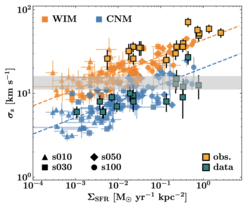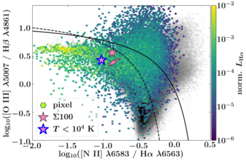Emission lines from the simulated interstellar medium
All stars in galaxies form in the dense gas of the interstellar medium (ISM). Ionizing radiation from newly born massive stars and supernova explosions lets the gas shine at characteristic wavelengths of certain atoms and ions. The relative strength of such line fluxes is an important observational diagnostic to reveal the internal state and composition of the ISM. However, emission by diffuse ionized gas has different flux ratios making accurate predictions difficult. Scientist at MPA and their European collaborators have used supercomputers to simulate a realistic star forming interstellar medium and to quantify the contribution of the diffuse gas. This finding allows for a more accurate interpretation of observations also at early cosmic times when these extreme conditions are more common than in the local Universe.
The interstellar medium (ISM) is the backbone of every galaxy that actively forms stars. Gas accreted from the cosmic web or returned from previous generations of stars accumulates here. Dense regions in the ISM cool and collapse into molecular clouds, the nursery of newly forming stars. Most of these stars have masses like our Sun or lower. However, about one in a hundred is more massive than eight solar masses. These massive stars emit strong ionizing radiation and expel material from their surfaces as stellar winds. At the end of their lives, they die as supernovae, dumping enormous amounts of energy into the ISM. These processes are termed as “feedback” and change the conditions of the ISM resulting in a complex interplay between star formation and the turbulent, multiphase structure of the gas. Modern supercomputer simulations can study this in detail.

Scientists at MPA and collaborators at the Universities of Cologne and Heidelberg, the Czech Academy of Sciences, the Institute d’Astrophysique de Paris, and the École Polytechnique Fédérale de Lausanne of the SILCC (Simulating the Life Cycle of molecular Clouds) supercomputing project have used SuperMUC-NG at the Leibnitz Supercomputing Center, one of the world’s fastest supercomputers, to simulate a realistic star forming ISM with all fundamental constituents. This includes gas, stars, radiation, and dust, but also the non-thermal components magnetic fields and cosmic-rays. The complex interaction of the ISM with stellar feedback processes has been simulated with conditions prevailing in a typical spiral galaxy in the local Universe, similar to the solar neighborhood. In addition, models with higher gas density represent more extreme conditions in the local Universe, like in interacting galaxies, or galaxies at earlier cosmic epochs with higher gas fractions.

The simulations are very realistic and explain many details seen in observations. Their multi-phase gas structure, star formation properties, and kinematic properties agree very well with direct ISM observations. In regions with higher star formation rates, the supernova explosions trigger higher turbulent velocities in the cold (< 300 Kelvin) and warm (~ 10000 Kelvin) gas with a similar trend as observed. At high star formation rates, the warm ISM motions become supersonic and magneto-hydrodynamic shocks become ubiquitous.
The ISM is mainly composed of hydrogen and helium but is also enriched with traces of heavier elements such as oxygen or nitrogen. When these elements are ionized and excited by stellar radiation, they start emitting at specific wavelengths when they return to lower energy levels. Some of these transitions, like the [OIII] emission of doubly ionized oxygen, happens in extremely rarefied gas which only exist in space, typically in so-called HII regions around massive stars. It is therefore sometimes referred to as a “forbidden” line. The relative strength of this line emission is an important observational diagnostic to reveal the internal state and composition of the ISM at all cosmic epochs.

For example, the flux ratios of emission lines are used to characterize e.g. the density of the ISM, abundances of heavy elements, or the source of the ionizing radiation. However, also in regions without massive stars and their ionizing radiation, shocks can heat up the gas leading to collisional ionization of the same elements. This diffuse ionized gas (DIG) has very different flux ratios than the gas ionized by stellar radiation in HII regions. The uncertain contribution of the DIG in observations makes accurate predictions about the ISM structure difficult.
The research team has used simulations of a large region of the ISM to construct detailed maps for the expected emission in hydrogen, oxygen and nitrogen lines. The whole region has flux ratio properties similar to the ISM of star forming galaxies in the local Universe. However, a much higher resolution reveals the contribution of the DIG. In the line-ratio diagram (known as the BPT diagram) it populates a region, which is traditionally associated with the presence of an active galactic nucleus. In this case, however, the ionized gas with a temperature of ~ 20.000 Kelvin is created by supersonic turbulence in the warm ionized gas (WIM) triggered by many supernova explosions.
Simulations and data analysis were carried out on supercomputers at MPCDF and SuperMUC-NG at the Leibnitz Supercomputing Center (LRZ).
This work is supported by
















